![]()
![]()
![]()
Use LEFT and RIGHT arrow keys to navigate between flashcards;
Use UP and DOWN arrow keys to flip the card;
H to show hint;
A reads text to speech;
93 Cards in this Set
- Front
- Back
|
Artifice <---> Nature
|
Artifice: anything created. Positive meaning such as artfulness or negative as in contrived. Artists choose whether or not to make artifice evident to viewer. Mannerism marked by conscious display of artifice (artful), but later critiques label as artificial.
|
|
|
Maniera
|
literally "style"; Mannerism marked by meaning of stylish style. Can be positive (stylish) or negative (mannered).
|
|
|
Artistic license
|
artist has freedom to do what he wants in a work of art; associated with Mannerism.
i.e. Michelangelo's Last Judgment |
|
|
Four Humors
|
body made up of four "humors" : blood (sanguine/passion; rabbit), phlegm (sluggish; ox), black bile (melancholic; elk), yellow bile (choleric; cat).
Good health/mood: BALANCE of humors. |
|

|
Descent from the Cross by Jacopo Pontormo, 1525-28, Mannerism painting, artifice
|
|
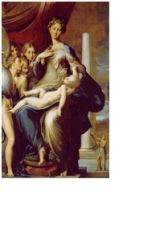
|
Madonna with the Long Neck by Parmigianino; 1535; Mannerism painting; artifice, ornament
|
|

|
Last Judgment by Michelangelo; 1534-41, Sistine Chapel; mannerism fresco; artistic license
|
|

|
Venus, Cupid, Folly and Time by Agnolo Bronzino; 1546, Medici family; mannerism painting; allegory (love), ornate, complexity
|
|
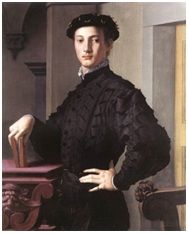
|
Portrait of a Young Man by Agnolo Bronzino; 1550; mannerism; ornate, artifice (staged)
|
|

|
Abduction of Sabine Woman by Giovanni da Bologna; 1583, Florence (Piazza della Signoria), Medici; Mannerism sculpture; colossal scale, view from all sides
|
|
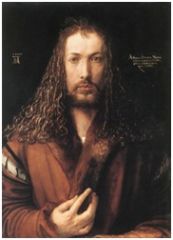
|
Self-Portrait by Albrecht Dürer; 1500; Northern European Art; oil painting, romanist
|
|

|
Adam and Eve (Fall of Man) by Albrecht Dürer; 1504; Northern European Art, engraving; four humors
|
|
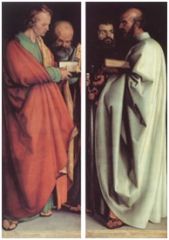
|
Four Apostles by Albrecht Dürer - 1526; to governors of Nuremburg; religious - NEA - Lutheranism, monumentality, northern particularity, illusionistic surfaces
|
|
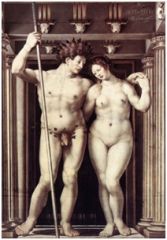
|
Neptune & Amphitrite by Jan Gossaert - 1516; Philip of Burgundy - NEA - Romanist, Northern (shell, gilded columns, bull heads)
|
|
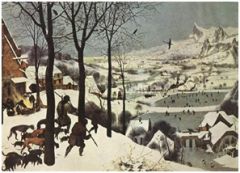
|
Hunters in the Snow by Pieter Bruegel - 1565 - NEA - Diagonal foreground, naturalism, "birds-eye-view," landscapes
|
|

|
Peasant Dance by Pieter Bruegel - 1568-69; Antwerp - NEA - Genre painting, caricature (drunks)
|
|
|
Romanist
|
Artist from northern Europe who journeys to Rome in order to study and learn from both ancient and modern Italian art
|
|
|
Genre Painting
|
depicts a scene apparently taken from everyday life; popularity began in 16th century; spread from northern europe to Italy
|
|
|
Reformation
|
A series of reform movements in Western Christendom beginning around 1515-20, which eventually led to a break with the Catholic church; reform churches popular in northern europe
|
|
|
Lutheranism
|
Reformation movement founded in Germany by Martin Luther (1483-1546); justification by faith alone; anti-indulgences; Luther excommunicated 1521
|
|
|
Baroque
|
originally applied to 17th-century art in a derogatory manner; irregular shapes & light; infinite space, revitalization of allegory, light, connection w/ viewer
|
|
|
Counter-reformation
|
"Catholic Reformation," beginning around middle 16th century and lasting into 17th; characterized series of internal reforms
|
|
|
Council of Trent
|
series of Catholic church councils in the North Italian city of Trent between 1545 and 1563, intended to establish a solid base for the renewal of discipline and spiritual life in the church; 1563 - role of art in church (educate illiterate but must be monitored closely)
|
|
|
Allegory of the Senses
|
popular in the 17th century, in which one or more of the five senses is represented by an action or object associated with it
|
|
|
tenebrism
|
a term used to describe paintings in which there is a preponderance of darkness; especially utilized by Caravaggio
|
|
|
Caravaggism
|
tenebrism; methods of bridging the gap between the fictive world of the painting and the real world of the spectator; flourished in Italy 1620s; italians, non-italian visitors, non-italian non-visitors
|
|
|
Quadratura
|
Illusionistic architectural painting; architecture continues beyond bounds of ceiling; Guercino's Aurora
|
|
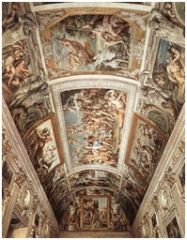
|
Loves of the Gods by Annibale Carracci - 1597-1601; Farnese Gallery; counter-reformers - ItalBar - quadro riportato ceiling; influence from Michelangelo & Titian
|
|
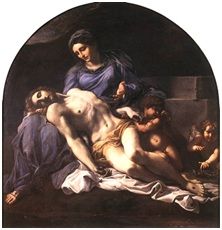
|
Pieta' by Annibale Carracci - 1600 - ItalBar - Humanize (emotional response)
|
|
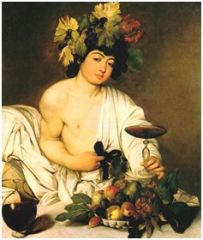
|
Bacchus by Caravaggio - 1590s - ItalBar - Allegory of the Senses, tenebrism
|
|
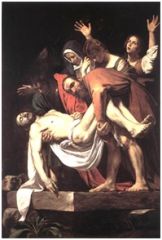
|
Entombment by Caravaggio - 1603 - ItalBar - Reject artifice & idealism
|
|
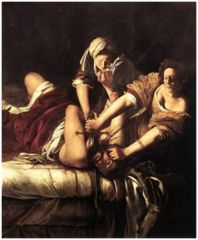
|
Judith Slaying Holofernes by Aremisia Gentileschi - 1614-20 - ItalBar - Caravaggism, bed comes to edge into our space
|
|
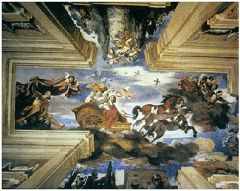
|
Aurora by Guercino - 1621-23; for cardinal nephew of Pope Gregory XV - ItalBar, fresco - quadratura
|
|

|
Triumph of Barberini - Pietro da Cortona - 1633-39; Pope Urban VIII - ItalBar, fresco - Illusionistic; Allegory; dynamism/dramatic contrast
|
|
|
Pendentives
|
In architecture, the four concave, generally triangular-shaped elements which support a dome
|
|
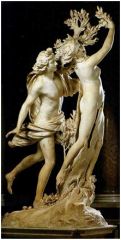
|
Apollo and Daphne by Gian Lorenzo Bernini - 1622-25; Cardinal Borghese - Italian Baroque; sculpture - Emotion; metamorphosis
|
|
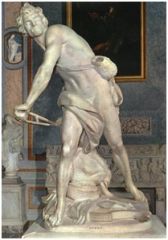
|
David by Gian Lorenzo Bernini - 1623; Cardinal Borghese - ItalBar sculpture - dramatic tension
|
|

|
Ecstasy of S. Teresa by Gian Lorenzo Bernini - 1645-52; Cornaro Chapel - Italian Baroque; sculpture; altarpiece - Hidden window (light)
|
|

|
S. Peter's nave & facade by Carlo Maderno - 1606-12; Rome - Italian Baroque; Architecture - extended greek cross
|
|
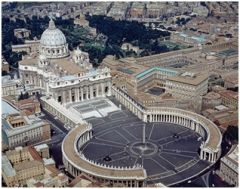
|
S. Peter's colonnaded piazza by Gian Lorenzo Bernini - 1656 - Italian Baroque; architecture - Redemption from failed towers; dynamic trapezoid & oval; Vitruvian man; monumentality
|
|
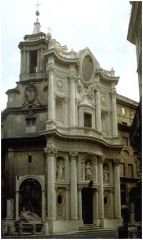
|
S. Carlino by Francesco Borromini - 1638-41; 65-76, façade ; Rome - Italian Baroque; architecture - More greek than latin cross; aka S. Carlino
|
|
|
oil sketch
|
preliminary study for a painting, done with oil paint, often times on panel. This compositional method was perfected by the Flemish painter Peter Paul Rubens, and combines elements of disegno with Venetian colorito
|
|
|
workshop
|
Collective name for the apprentices training under, and assistants employed by, a master artist (Peter Paul Rubens, Maria de' Medici)
|
|

|
Drawing of Laocoon by Peter Paul Rubens - 1600-08 - FBA - During his Italian sojourn made a number of studies after this Hellenistic statue group
|
|
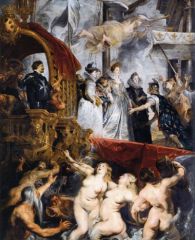
|
Arrival of Maria de' Medici at Versailles by Peter Paul Rubens - 1622-25 - FBA - Workshop effort; oil sketch; hyperbole; allegory & mythology
|
|
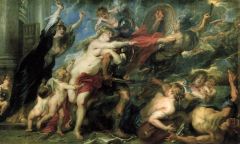
|
Outbreak of War by Peter Paul Rubens - 1638 - FBA - Allegory; mythology with Venus, Cupid, and Mars; temple door (war); war tramples fruits of peace
|
|
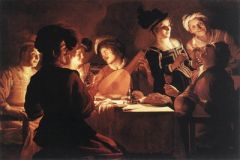
|
Supper Party by Gerrit van Honthorst - 1620 - DBA - Caravaggist; allegory of the senses; genre painting (old lady, house of ill repute)
|
|
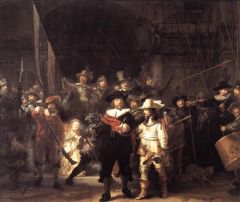
|
Night Watch by Rembrandt - 1642 - DBA - Militia Company of Frans Banning Cocq; call to order; not all figures in focus
|
|
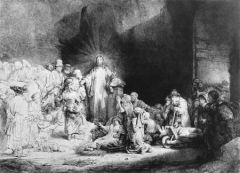
|
Hundred Guilder Print by Rembrandt - 1649 - DBA - drypoint & etching
|
|
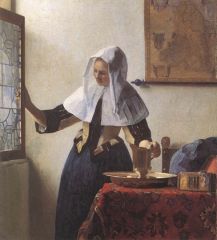
|
Young Woman with a Water Jug by Jan Vermeer - 1665 - DBA - Camera obscura for light effects
|
|
|
etching
|
Grounding, Engraving, Biting, Removing Ground, Inking, Wiping Plate, Printing
|
|
|
drypoint
|
A printmaking technique in which a metal plate is scratched directly with a needle, making raised ridges (called a burr)
|
|
|
camera obscura
|
light-tight box which has a small hole in one side that can be fitted with a lens; artist can trace contours of light image; i.e. Jan Vermeer
|
|
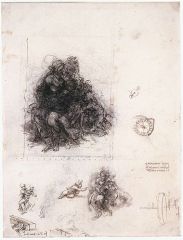
|
Sketch for Virgin, Child, and S. Anne by Leonardo da Vinci - 1505 - IHR, MF - externalized imaginative process
|
|
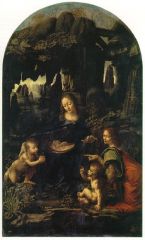
|
Virgin of the Rocks by Leonardo da Vinci - 1483; Duke
Ludovico Sforza of Milan - IHR; altarpiece - Atmospheric perspective (rocks); use of natural setting |
|
|
microcosm and macrocosm
|
idea that the human body (microcosm--i.e., small world) and the universe (macrocosm--i.e., large world) mirror one another in various ways; characteristic of Leonardo da Vinci
|
|
|
cartoon
|
A drawing made on heavy paper which serves as a full-scale template for a painted work
|
|
|
colossus
|
A statue or painting that is at least three times life-size; great examples of difficultà
|
|
|
Terribilità
|
capacity to inspire awe; especially notable in works of Michelangelo
|
|
|
sketch
|
quick or "messy" drawing in which an artist sets down his first thoughts for a figure or composition (i.e. Leonardo's chaotic sketches)
|
|
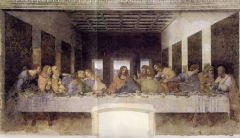
|
The Last Supper by Leonardo da Vinci - 1495-98; Duke
Ludovico Sforza of Milan; S. Maria delle Grazie - IHR; fresco |
|
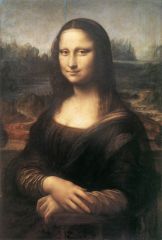
|
Mona Lisa by Leonardo da Vinci - 1503-05 - IHR - Portrait of Lisa Gherardini; cut down from original size
|
|
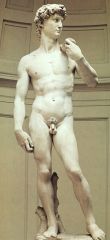
|
David by Michelangelo - 1501-04 - IHR; statue - "David with the sling, and I with the bow."
|
|
|
process over product
|
concept exemplifying work by Leonardo da Vinci
|
|
|
virtue of difficulty
|
concept exemplifying work by Michelangelo
|
|
|
triumph of emulation
|
concept exemplifying work by Raphael
|
|
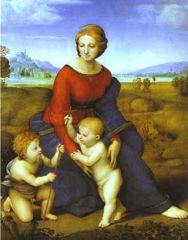
|
Madonna of the Meadow by Raphael - 1506 - IHR - emulation of Leonardo's Virgin of the Rocks
|
|
|
central plan
|
type of plan in which all parts radiate from a central point (include greek cross)
|
|
|
"Vitruvian Man"
|
A schema in which a perfectly proportioned human body touches (in various positions) the outlines of a square and a circle; Leonardo & Bramante
|
|
|
greek cross plan
|
transept crosses the nave at its midpoint and is same length as nave
|
|
|
Figura serpentinata
|
used to describe the human figure twisting on its axis; the shoulders and hips of a figura serpentinata consequently occupy different planes; favored by HR & Mannerist periods; perfected by Leonardo & Michelangelo
|
|
|
sprezzatura
|
conceals all artistry and makes whatever one says or does seem uncontrived and effortless (Baldassare Castiglione)
|
|
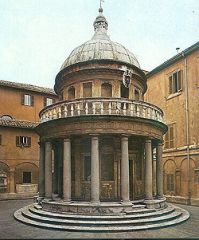
|
Tempietto by Donato Bramante - 1502; courtyard of S. Pietro in Montorio - RHR - would have ideally been placed in a circular courtyard), Bramante uses a purely classical architectural vocabulary to create a new kind of central-plan church.
|
|
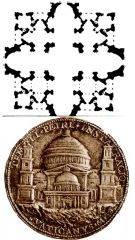
|
Plan for New S. Peter's/ Caradosso Medal by Donato Bramante/ Caradosso - 1506 - RHR - Greek Cross Plan
|
|
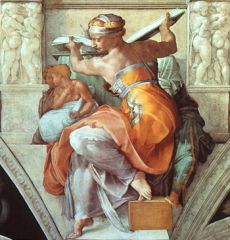
|
Libyan Sibyl by Michelangelo - 1508-12; sistine chapel ceiling fresco - RHR - figura serpentinata; impossible pose
|
|

|
Preliminary drawing for libyan sibyl by Michelangelo
|
|
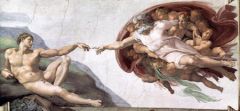
|
Creation of Adam by Michelangelo - 1508-12; sistine chapel ceiling fresco - RHR - monumentalized representation of God imbuing Adam with life; fingertips = point of tension
|
|
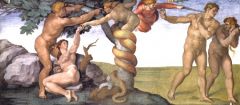
|
Temptation and Expulsion of Adam & Eve by Michelangelo - 1508-12; sistine chapel ceiling fresco - RHR - figura serpentinata; masculine figures; lack of detail to setting
|
|
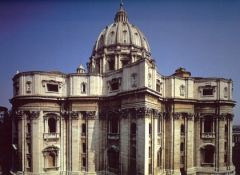
|
Plans for S. Peter's, East End by Michelangelo - 1546-64 - RHR - altered greek cross plan; Emulation, vs. Bramante: square (simplifies), thickened piers to hold up dome (strengthens); Layered pilasters, travertine stone: 3-D effect (sculpted building)
|
|
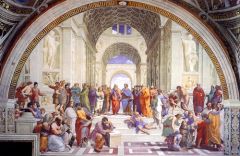
|
Philosophy (School of Athens) by Raphael - 1509-11; Stanza della Segnatura; Vatican - RHR; fresco - subjects of allegories correspond to the four large subject categories into which libraries at the time were divided: philosophy, theology, jurisprudence and poetry (literature)
|
|
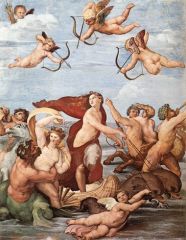
|
Galatea by Raphael - 1513; Villa Farnesina; Agostino Chigi - RHR; fresco - figura serpentinata; private patron; HR mythology
|
|
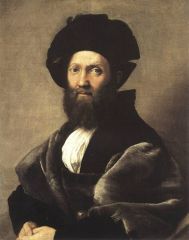
|
Baldassare Castiglione by Raphael - 1514 - RHR - Wealth shown subtly (The Book of the Courtier: on acquiring grace)
|
|

|
Laocoon and His Sons - Early 1st Century; Rome - Recovered 1506 - influential sculpture group
|
|
|
oil on canvas
|
sixteenth century Venetian painters often used canvas as a support. Venetian canvases were often of a particularly coarse weave, and artists such as Giorgione did not attempt to hide the surface texture of the support
|
|
|
disegno
|
strongly associated with central Italian art (i.e., works by artists trained in Tuscany), especially that of Michelangelo. Art that possessed good design was generally believed to be the result of much preliminary drawing
|
|
|
colorito
|
describes actual application of paint was a crucial stage in the creative process, and they sometimes changed a composition while they were painting it.
|
|
|
impasto
|
Paint applied thickly, so that brushstrokes are evident on the paint surface
|
|
|
Pentimento
|
Literally repentance (as in a change of heart). A pentimento occurs when an artist rethinks a feature or an area of his painted composition and covers that original idea with a new layer of opaque paint
|
|
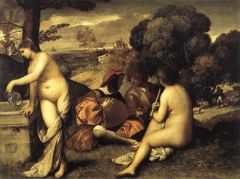
|
Pastoral Symphony by Giorgione - 1508 - VHR; oil on canvas - Allegory of poetry (musical instruments); impasto
|
|

|
Tempest by Giorgione - 1505-10 - VHR - Allegory: fortitude, charity, fortune- w/ you can outlast any misfortune
|
|
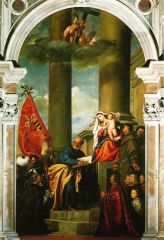
|
Madonna of the Pesaro Family by Titian - 1519-26; Frari Church - VHR - Sacra conversatione; diagonal perspective (side wall); pentimento; colorito
|
|
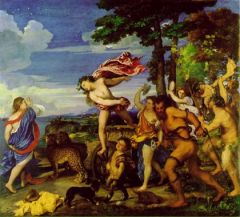
|
Meeting of Bacchus & Ariadne by Titian - 1522-23; Alfonso D'Este - VHR - Gaze b/w ariadne & bacchus; not ideal woman (Venetian); colorito; laocoon man: statement about Michel.
|
|
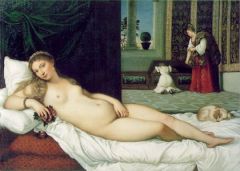
|
Venus of Urbino by Titian - 1538 - VHR - Private patron; nature & artifice; Renaissance erotic painting
|

